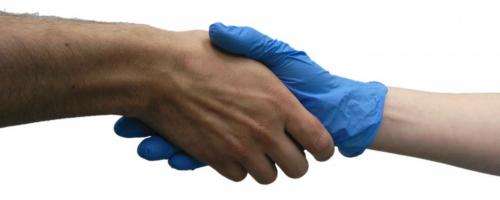People use handshakes to sniff each other out

Limp or firm, your handshake conveys subliminal social cues. Now, research reveals it also transmits chemical signals that could explain why the greeting evolved in the first place.
In the study, published in the journal eLife, scientists from Israel's Weizmann Institute of Science found that people use the touch of a handshake to sample and sniff signalling molecules.
During the experiment, around 280 people were greeted either with or without a handshake. They were filmed using hidden cameras and observed to see how many times they touched their face. One finding of the study was that people constantly sniff their own hands—keeping a hand at their nose about 22% of the time. Subjects greeted with a handshake significantly increased touching of their faces with their right hand. However, this only seemed to be the case when the subject had been greeted by a person of the same gender.
To check that the observed face-touching was being used as a way to subtly sniff the hand used in handshaking, subjects were fitted with nasal catheters to measure airflow. They found that when a hand was in close proximity to the nose airflow through the nasal passages doubled. In other words, the subject was sniffing.
""It is well-known that we emit odours that influence the behaviour and perception of others but, unlike other mammals, we don't sample those odours from each other overtly," says Professor Noam Sobel, Chair of Neurobiology at the Weizmann Institute of Science.
"Instead, our experiments reveal handshakes as a discreet way to actively search for social chemosignals," he said.
Previous studies have suggested that human chemosignals play a role in mate selection, conveying fear, altering brain activity, and synchronising women's menstrual cycles. To confirm that handshaking is effective at passing on this type of chemical, the scientists analysed the content of sterile gloves used to shake the hands of the subjects. They found that squalene and hexadecanoic acid, both chemicals thought to play a part in social signalling in dogs and rats, were transferred onto the gloves.
"Handshaking is already known to convey a range of information depending on the duration of the gesture, its strength and the posture used," says Professor Sobel. "We argue that it may have evolved to serve as one of a number of ways to sample social chemicals from each other, and that it still serves this purpose in a meaningful albeit subliminal way."
More information: The paper 'A social chemosignalling function for human handshaking' can be freely accessed online at dx.doi.org/10.7554/eLife.05154
An Insight article, 'Social chemosignaling: The scent of a handshake,' authored by Gün R. Semin & Ana Rita Farias of the Instituto Universitário, Lisbon, Portugal is available at dx.doi.org/10.7554/eLife.06758


















